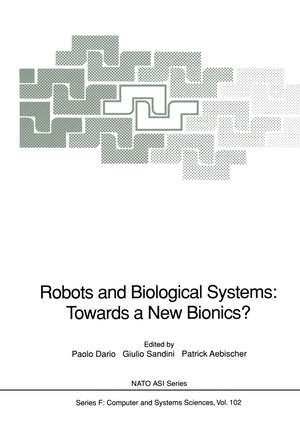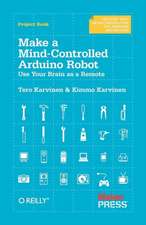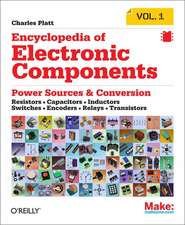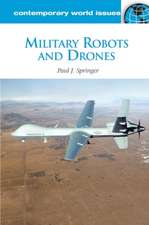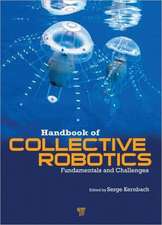Robots and Biological Systems: Towards a New Bionics?: Proceedings of the NATO Advanced Workshop on Robots and Biological Systems, held at II Ciocco, Toscana, Italy, June 26–30, 1989: NATO ASI Subseries F:, cartea 102
Editat de Paolo Dario, Giulio Sandini, Patrick Aebischeren Limba Engleză Paperback – 8 noi 2012
| Toate formatele și edițiile | Preț | Express |
|---|---|---|
| Paperback (1) | 1928.45 lei 6-8 săpt. | |
| Springer Berlin, Heidelberg – 8 noi 2012 | 1928.45 lei 6-8 săpt. | |
| Hardback (1) | 1929.74 lei 6-8 săpt. | |
| Springer Berlin, Heidelberg – 14 iun 1993 | 1929.74 lei 6-8 săpt. |
Din seria NATO ASI Subseries F:
- 20%
 Preț: 650.27 lei
Preț: 650.27 lei - 20%
 Preț: 668.55 lei
Preț: 668.55 lei - 20%
 Preț: 992.44 lei
Preț: 992.44 lei - 18%
 Preț: 1239.19 lei
Preț: 1239.19 lei - 20%
 Preț: 654.37 lei
Preț: 654.37 lei - 18%
 Preț: 1234.00 lei
Preț: 1234.00 lei - 20%
 Preț: 709.78 lei
Preț: 709.78 lei - 20%
 Preț: 656.03 lei
Preț: 656.03 lei - 18%
 Preț: 1854.94 lei
Preț: 1854.94 lei - 20%
 Preț: 374.97 lei
Preț: 374.97 lei - 20%
 Preț: 991.94 lei
Preț: 991.94 lei - 20%
 Preț: 671.02 lei
Preț: 671.02 lei - 20%
 Preț: 1925.96 lei
Preț: 1925.96 lei - 20%
 Preț: 994.73 lei
Preț: 994.73 lei -
 Preț: 389.49 lei
Preț: 389.49 lei - 20%
 Preț: 657.99 lei
Preț: 657.99 lei - 20%
 Preț: 655.20 lei
Preț: 655.20 lei - 18%
 Preț: 1225.31 lei
Preț: 1225.31 lei - 18%
 Preț: 952.09 lei
Preț: 952.09 lei - 20%
 Preț: 332.06 lei
Preț: 332.06 lei - 20%
 Preț: 1284.47 lei
Preț: 1284.47 lei - 20%
 Preț: 644.81 lei
Preț: 644.81 lei -
 Preț: 395.85 lei
Preț: 395.85 lei - 18%
 Preț: 1221.07 lei
Preț: 1221.07 lei - 15%
 Preț: 643.34 lei
Preț: 643.34 lei - 20%
 Preț: 645.47 lei
Preț: 645.47 lei - 20%
 Preț: 1282.98 lei
Preț: 1282.98 lei - 20%
 Preț: 656.36 lei
Preț: 656.36 lei - 20%
 Preț: 1283.31 lei
Preț: 1283.31 lei - 20%
 Preț: 1924.15 lei
Preț: 1924.15 lei - 20%
 Preț: 362.24 lei
Preț: 362.24 lei
Preț: 1928.45 lei
Preț vechi: 2410.56 lei
-20% Nou
Puncte Express: 2893
Preț estimativ în valută:
369.01€ • 380.69$ • 307.94£
369.01€ • 380.69$ • 307.94£
Carte tipărită la comandă
Livrare economică 27 martie-10 aprilie
Preluare comenzi: 021 569.72.76
Specificații
ISBN-13: 9783642634611
ISBN-10: 3642634613
Pagini: 808
Ilustrații: XII, 786 p.
Dimensiuni: 170 x 242 x 42 mm
Greutate: 1.26 kg
Ediția:1993
Editura: Springer Berlin, Heidelberg
Colecția Springer
Seria NATO ASI Subseries F:
Locul publicării:Berlin, Heidelberg, Germany
ISBN-10: 3642634613
Pagini: 808
Ilustrații: XII, 786 p.
Dimensiuni: 170 x 242 x 42 mm
Greutate: 1.26 kg
Ediția:1993
Editura: Springer Berlin, Heidelberg
Colecția Springer
Seria NATO ASI Subseries F:
Locul publicării:Berlin, Heidelberg, Germany
Public țintă
ResearchCuprins
1. Vision and Dynamic Systems.- Active Perception and Exploratory Robotics.- Object Identification and Search: Animate Vision Alternatives to Image Interpretation.- A Model of Human Feature Detection Based on Matched Filters.- Visualizing and Understanding Patterns of Brain Architecture.- Dynamic Vision.- A Model of the Acquisition of Object Representations in Human 3D Visual Recognition.- 2. Hands and Tactile Perception.- The Perception of Mechanical Stimuli Through the Skin of the Hand and Its Physiological Bases.- Borrowing Some Ideas from Biological Manipulators to Design an Artificial One.- Mechanical Design for Whole-Arm Manipulation.- Whole-Hand Manipulation: Design of an Articulated Hand Exploiting All Its Parts to Increase Dexterity.- Stable Grasping and Manipulation by a Multifinger Hand with the Capability of Compliance Control.- 3. Locomotion.- Mobile Robots — the Lessons from Nature.- Quadruped Walking Machine — Creation of the Model of Motion.- Biped Locomotion by FNS: Control Issues and an ANN Implementation.- How Fast Can a Legged Robot Run?.- Robot Biped Walking Stabilized with Trunk Motion.- 4. Intelligent Motor Control.- A New Concept of the Role of Proprioceptive and Recurrent Inhibitory Feedback in Motor Control.- Analogic Models for Robot Programming.- Structural Constraints and Computational Problems in Motor Control.- Motion Control in Intelligent Machines.- Control of Contact in Robots and Biological Systems.- Motor Control Simulation of Time Optimal Fast Movement in Man.- Constraints on Underspecified Target Trajectories.- Proposal for a Pattern Matching Task Controller for Sensor-Based Coordination of Robot Motions.- Sensory-Motor Mapping with a Sequential Network.- 5. Design Technologies.- Flexible Robot Manipulators and Grippers:Relatives of Elephant Trunks and Squid Tentacles.- Progress in the Design and Control of Pseudomuscular Linear Actuators.- Shape Memory Alloy Linear Actuators for Tendon-Based Biomorphic Actuating Systems.- CCD Retina and Neural Net Processor.- Retina-Like CCD Sensor for Active Vision.- Designing Artificial Structures from Biological Models.- Design Strategies for Gas and Odour Sensors Which Mimic the Olfactory System.- 6. Interfacing Robots to Nervous System.- Multi-Electrode Stimulation of Myelinated Nerve Fibers.- The Role of Materials in Designing Nerve Guidance Channels and Chronic Neural Interfaces.- Regeneration-Type Peripheral Nerve Interfaces for Direct Man/Machine Communication.- Integrated Bioelectronic Transducers.- 7. Robot Societies and Self-Organization.- A Robot Being.- Swarm Intelligence in Cellular Robotic Systems.- A Control Architecture for Cooperative Intelligent Robots.- Cellular Robotics — Construction of Complicated Systems from Simple Functions.
